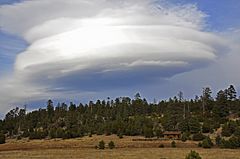Lenticular cloud facts for kids

A lenticular cloud (also known as Altocumulus lenticularis) is a special type of cloud. These clouds form high up in the sky. They often look like smooth, round discs or lenses, almost like a stack of pancakes! Because of their unique shape, they sometimes get mistaken for UFOs.
Contents
What Are Lenticular Clouds?
Lenticular clouds are unique because they often stay in one spot in the sky. They don't move much, even when the wind is blowing strongly. This happens because of how they form, usually near mountains or hills. They are sometimes called "saucer clouds" because of their shape.
How Do Lenticular Clouds Form?
Lenticular clouds form when strong winds blow across a mountain range. Here's how it works:
- As the wind hits the mountain, it's forced to rise up and over the peak.
- As the air goes higher, it gets cooler.
- When the air cools enough, the water vapor inside it turns into tiny water droplets or ice crystals. This is how clouds are made!
- After passing over the mountain, the air sinks down again. As it sinks, it warms up, and the water droplets turn back into invisible vapor.
- This creates a wave-like pattern in the air. Lenticular clouds form at the top of these waves, where the air is cool enough for water vapor to condense. Because the air is constantly flowing through this wave, the cloud looks like it's staying still, even though the air inside it is moving.
Why Do Lenticular Clouds Look Like UFOs?
Their smooth, disc-like shape and tendency to stay in one place can make lenticular clouds look very unusual. From a distance, especially at dawn or dusk, they can easily be mistaken for UFOs or flying saucers. This is why they are often mentioned when people talk about strange things seen in the sky.
Images for kids
-
A lenticular cloud covers the summit crater of Mayon Volcano, Philippines.
See also
 In Spanish: Nube lenticular para niños
In Spanish: Nube lenticular para niños



